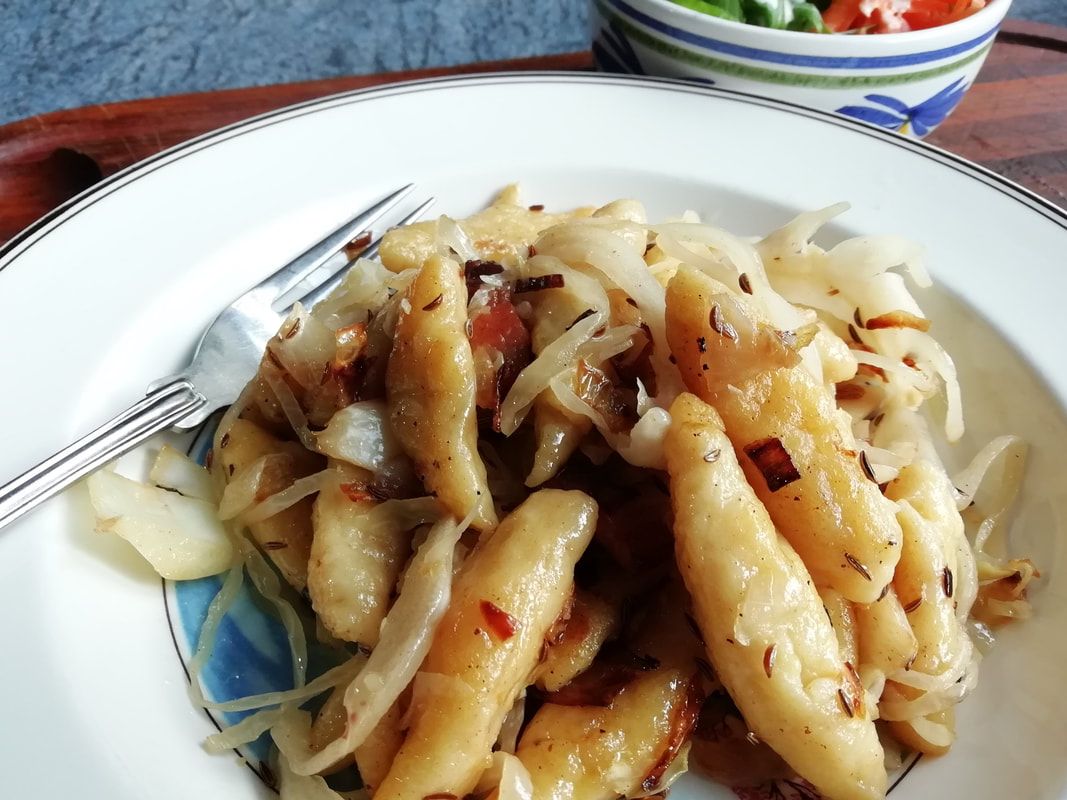|
Schupfnudeln (vegetarian optionally)
They sound odd, but they’re plump and fluffy and delicious, and surprisingly easy to make. They’re the German equivalent of the Italian gnocchi, which gives you an idea of the texture. The name just means “pinched dumplings” which indicates that you don’t need a machine to make them. They’re not usually eaten with a tomato sauce (for no good reason that I can think of, it’s one of those “just so” questions), but are fried up with some well flavoured meat, soaking up the fat and pan juices. In the Munich Christmas Market you will find schupfnudeln billowing their savoury smell along the alleys of wooden huts, heaving with woolly-wrapped merry makers. The dumplings are fried up with smoked bacon, sweet onions, tangy sauerkraut and a sprinkling of caraway seeds for a very characteristic taste. Spear them with a fork; and enjoy a genuine continental Christmas treat. Preparation: Peeling and boiling potatoes – 30 minutes. Then making the dumplings – 1 hour. Final preparation – 20 minutes.
Mix the mashed potato, flour and eggs together, season with salt and pepper. Use your hands to form a soft dough and mix well, but don’t knead. Cover the dough and chill in the fridge while you bring a large pan of salted water to the boil. Remove 1/6th of the dough from the lump. Roll it on a floured worktop, like rolling playdough into a long snake about 2cm thick. Pinch off pieces about 2cm long and roll on your palm - the shape of your hand will naturally make a worm-shaped piece of dough, thinner at the ends than at the middle. This is what you want. Roll about 25 pieces like this and drop them into the boiling water. Don’t overload the pan, you want the water to retain the heat and boil the batch up quickly. They will rise to the top and expand as they cook, taking about 1-2 minutes. Scoop out the cooked dumplings and place them on a fine wire rack or on a tea towel, so they don’t sit in liquid. Keep going until you’ve done all the dough. You get quicker as you go along! At this stage you can cool your schupfnudeln and keep them for a day covered in the fridge until you want to cook them. You can also freeze them on a metal tray and put them in a bag once frozen. Cook straight from frozen, without thawing if you do this. About 30 minutes before eating, start to fry your bacon in your largest frying pan in a generous amount of vegetable oil. Fry until browned and starting to crisp, then add your onions to the pan. Fry for a few minutes until transparent and starting to brown and then add the shredded cabbage. Fry for another few minutes and then add the butter to the pan. When sizzling, add the caraway seeds and tip in your schupfnudeln. Turn with a spatula to brown all sides and warm through, then add the sauerkraut to the pan. Fry a little longer to cook through, adding a little more butter if you need.
0 Comments
Leave a Reply. |
Some Changes - April 2022
Thanks to my friends and followers for your patience, and for your encouragement to start blogging again. Archives
April 2022
Categories
All
|

 RSS Feed
RSS Feed
